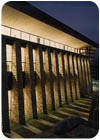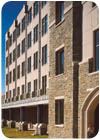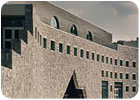
The firm's design for the Georgia Public Health Building helped it to win the Laboratory of the Year Award in 1998. For this project, scrap granite was brought out and broken on site and put into the wall.
Based in Atlanta, GA, Lord Aeck Sargent is a fusion of the architecture firms Aeck Associates, which was founded in 1942, and Lord & Sargent, started in 1983. The two firms joined forces in 1989. Today, Lord Aeck Sargent has grown to 115 employees, and operates branch offices in Ann Arbor, MI, and Chapel Hill, NC.
With four design studios - education, historic preservation, science, and arts and culture - the firm has a diversified client base and has designed projects nationwide. Revenues were $15.4 million in 2002 and approximately $18.8 million in 2003. Lord Aeck Sargent has received more than 55 national, regional, state and local distinctions, including multiple American Institute of Architects Honor Awards for Excellence in Architecture and three R&D Magazine Laboratory of the Year and Special Mention awards. cafeteria.

At Duke University, Lord Aeck Sargent completed a high-tech research laboratory called the Genome Sciences Research Building. The exterior is clad with “Duke Stone,†which is used throughout the campus.
The firm prides itself on its responsive design approach, technological expertise and exceptional client service. It strives to design new structures that are meant to last indefinitely, yet are flexible enough to adapt to future changes to their original intended function; handles everything from the delicate restoration and rehabilitation of centuries-old buildings to the design of complex, interdisciplinary science research laboratories; and provides a high level of interaction with its clients throughout the entire planning, programming, design and construction process.
Among some of Lord Aeck Sargent's most notable works are the design of the Georgia Public Health Laboratory, Riverside Military Academy, Mt. Carmel Elementary School in Atlanta, and work at Duke University. These projects are not only innovative and illustrate the firm's attention to detail and technical expertise, but also demonstrate various - and often unique - uses for natural stone.
Contemporary Stone & Tile Designhad the opportunity to sit down with some members of the firm to discuss the function of natural stone in their designs.
Participants in the roundtable discussion included:
- Antonin Aeck, FAIA, Principal
- Joseph Greco, AIA, LEED Accredited, Principal
- Richard E. Robison, R.A., C.C.S., Principal
- Susan M. Turner, AIA, Principal
Aeck:The work of the firm, which has been going on now for more than 61 years, is hard to describe in a word or two. But talking about our current situation, we are a family of specialty practices. We have four studios at the present time - science, historic preservation, education, and arts and culture. In addition to having those specialty practice areas, we have three offices. We have a headquarters in Atlanta, and branch offices in Ann Arbor, MI, and Chapel Hill, NC. From those centers, we accomplish projects - architectural, interior design, planning and preservation type services. We've grown an average of 20% in each of the last five years.
Robison:In any of those practice groups, they tend to be whole buildings as opposed to interiors only or a shell only. It tends to be an entire building for a dedicated user who owns the building.
Aeck:As you might expect, not everything fits neatly in a basket like that. There are clients for whom we've done mosques and clients for whom we've done unusual kinds of projects - one-of-a-kind assignments. We do whatever we need to do to serve a client.
CSTD:How often does your work include natural stone?
Greco:We hadn't really thought about it until we sat down to count how many of our projects used natural stone in the last four or five years. We were actually astounded by how many of them there were, and how many different types of uses we've found. The projects ranged from historic preservation work- where you are really restoring the stone and trying to understand the original use - to a project like the Georgia Public Health Lab, which is a very contemporary building with contemporary use of an indigenous stone, cut granite found in the Georgia area. We've actually used this type of stone a number of times as well as rounded Creek Rock that is an indigenous stone for some projects in North Carolina. We were surprised that 35 to 40% - or maybe even 50% - of significant recent projects had some element of stone in them.
Aeck:I joke that the first half of our long professional career was spent trying to stay out of rock with our foundations because we didn't have budgets. Then we started using it to build our buildings, and we are much happier in our second half.
CSTD:I was told that the Georgia Public Health Lab is made from salvaged tombstones.
Aeck:We don't know the exact quantity of it, but we understand that in some measure it was essentially scrap granite that was brought out and broken on site and put into the wall.
CSTD:How did that come about?
Robison:In north Georgia, there is a very significant cemetery/monument industry.
Aeck:In fact, right outside of Athens is [a replica of] “Stonehenge,†although it leaves a little something to be desired.
Greco:When we're looking for another masonry material to compete with brick on relatively limited budgets, it certainly rules out some applications of stone. We found that this particular application [at Georgia Public Health Lab] essentially is relatively competitive with brick masonry and provides another option. This was done five or six years ago. It won the Laboratory of the Year Award in 1998. It's a pretty innovative laboratory design in addition to being a very striking image. It's very efficient. In a lot of ways, it's just a rectangle in the plan and the way it's set up it has service to the rear of the building. That's where the “dirty corridor†is. It has a large open laboratory area off to the left and a working administrative zone in the middle. And to the right of it - just beneath the clerestory - are the laboratory's offices. So what we've done by sloping the roof is to bring light very deep into the building. It effectively saves a lot of money, and therefore, theoretically affords stone.
Aeck:If stone is expensive, it's offset by very inexpensive material. We also used Victorian shingle. It's copper, and has been made to last for 100 years too. When you average the cost per square foot, this was successful enough that we've used this palette again. It's a successful blend to get an acceptable unit cost for the exterior wall treatment.
Robison:The size of this building is like a large supermarket or maybe a small to medium Wal-Mart. The shape of the slope ceiling and clerestory lighting allows you to be back in the depths of the building and still see the light of day outside. You're seeing the sky and the trees outside. It makes a tremendous difference for the people who work inside. This is basically a factory. It's not a research facility. It's where thousands upon thousands upon thousands of samples come from all over the state of Georgia from clinics and offices. There's TB tests, smallpox tests, polio tests and other public health types of tests. They are collected and centralized here, and they're analyzed for the children and the adults of families here in Georgia. It's an assembly line environment that could be very dull and dreary if not relieved by natural daylight.
CSTD:The pattern of the stone on this building seems like it would be very dependent on the talent of the mason.
Aeck:That's the Clack family here in Georgia. They have been doing this for generations.
CSTD:Do you see a mock-up beforehand, or do you visit the site a lot while it's going on?

At North Atlanta High School, the firm's task was to double the size of the original school, which had already undergone several renovations. The use of local granite unified the building and gave it a solid street presence
Another project is Atlanta Global Health Action in Decatur, GA. This is just up the street from the Georgia Public Health Lab in Decatur. It's quite a bit smaller building. It's about a 20,000-square-foot building on a very limited budget. The whole budget is in the vicinity of $130 per square foot for the building. It has some training rooms on the upper levels and primarily offices on the lower level. It's a very similar palette of materials [as the Georgia Public Health Lab] with the granite and the copper but in a different way. It's more of a stone wall as opposed to a series of stone piers.
CSTD:Would you say that this firm has a specific design style or philosophy, or does it pretty much vary from project to project?
Greco:The studios have essentially the same basic philosophies, although I think there are a lot of technical differences in historic preservation, where rather than creating new, it's more about trying to find and understand the initial building and the initial intent, and to restore that.
As far as our philosophy goes, we believe that most of our buildings are going to be around a long time. They need to be durable, and they need to be timeless - not highly stylistic necessarily, but something that will endure well. We believe strongly that building materials have an inherent integrity, and we try to use materials in that way - in some kind of honest, straightforward way. A lot of our buildings have a real strong play between solidity and mass, and light as well. We really believe that all natural light should be brought into all the spaces - well deep into the building. So you will see that a lot of our projects have clerestory [windows.] Those are some of the key ones that I think occur from project to project.
Turner:I think Joe said it very nicely. We're always trying to strike a balance. With Historic Preservation Studio projects, there are often adaptations that we have to make to an historic structure to help it function in today's world, and we are also preserving it for future generations. I think our design philosophy tends to be very stewardship-based in that we realize that we have a resource that we're working with, and we have an obligation to keep it intact for future generations. At the same time, we have to keep it functioning and working, and so we have to understand them before we can work on them. And we work really hard not only to understand the history of the building and how it has changed over time, but understand its materials and how they will react to different treatments and repair methods. So we really strive for compatibility with existing materials, and we take a stance of trying to preserve what is there as much as possible. We also want to make our changes very compatible and truly match existing materials so where we are working with stone, we work very hard to try to match the stone, the mortar and all of the components.
CSTD:Have you found that certain projects that you do are more conducive to the use of stone? Obviously on a restoration project if stone is there, stone will be in the restoration. How about in other sectors?
Aeck:For many of the institutional buildings we design, the use of some stone is a fairly commonplace thing for us and for owners to accept.
Greco:There's certainly no discernable pattern for not using stone, if you have a typical budget for all of these relatively technical buildings. Occasionally, we will have something that it would just be out of the question to use. Budget-wise, that doesn't really come up that often.
At Mount Carmel Elementary School, we used stone on the interior hallway just because it is durable, and it was in a relatively low quantity and overall building cost per square foot was very low. This was done a number of years ago, but it's a very cost-effective building. It has large open space with long-span bar joists. It has sheetrock walls, which used to be taboo in the world of elementary schools, but to deal with this problem of durability, we used the stone where you can touch it, and we used inexpensive material where you couldn't. Nobody has ever really been that fond of what concrete block looks like anyway, so we thought it was a good solution.
There's granite on the wall where the kids can touch it, but it's just sheetrock above. I think we did an economical analysis on it, and it turned out that it cost about the same as just building the whole thing out of concrete block and painting it. The whole point is that you don't need the whole wall to be built out of concrete block, you just need it to be durable where it needs to be durable. We try to look for strategies like that to get nicer, more interesting finishes into our buildings.
CSTD:What are some of your positive experiences of working with stone? Can you point to any projects that pleasantly surprised you?
Robison:We have had lots of positive experiences. The Georgia Public Health Lab is one. This building, like so many of our buildings, has a fairly customary institutional budget. When we make use of stone, we're doing so in the context of a “standard†publicly funded budget. In other cases, it's a privately funded budget, but they can be as conservative and as tight as a public project.
There are numerous examples of stone. The Georgia Public Health Lab used granite scrap as we mentioned. We're doing another public health lab for the state of Georgia. We've used “Duke Stone†at Duke University - we wouldn't use anything else there.
At Duke University, we completed a high-tech research laboratory called the Genome Sciences Research Building II. Of course they have a mandate that you utilize “Duke Stone†in all of the buildings - at least to some measure. In this case, we used it at the lower levels to create some of the tower elements and interest elements of the building. It works in with a cast stone and pre-cast system and picks up some of the other colors and patterns on campus, but in a bit more contemporary and a little more interpretive way.
CSTD:How about negative experiences, where something just didn't go right? Has there been a stone project that you look back at and wish you used a different stone or detailed it differently?
Aeck:We had an experience years ago on a building where we actually worked with an outside specification consultant, because we hadn't used a lot of stone veneer. It was at a period of time when the old mud-and-wire techniques were evolving to more mechanical fastening techniques. I don't think they served us well in what they specified. When we subsequently expanded that building, we utilized more contemporary methods, and that worked out quite well. I think we saw both sides - how well it could work and what doesn't work.
Also, I think in the early days of thin stone, some of the veneers were just too thin. They were trying to sell material probably for cost reasons and as a result, they tried to do things that were probably too aggressive.
Robison:And we're fortunate that in this respect our buildings tend to be two, three, five, six stories tall, and so we didn't have the negative experience of the 20-, 30- or 40-story office buildings where the very best and the brightest architects and engineers and stone consultants were trying to do more with less in shorter times with less weight, and learned some things in the process of doing that. We weren't on that learning curve ourselves.
Greco:There's a fair amount of historic stone that we deal with. I think by and large we use more of a masonry type configuration for stone rather than a thin hung panel. We have a few examples where it is panelized stone, but those are obviously the ones that have had the more known problems.
Martin: The only time I have seen something negative with stone was when it was either installed improperly or it was asked to do something that it wasn't really supposed to do. When we see it in the Historic Preservation studio, it's at least 100 years old, and every time there is a problem there is a design or installation issue behind it.
Robison:And those have been few and far between.
Martin: They have been. I mean the quality of the stonework was exemplary in general.
CSTD:Can you tell me about some of your renovation work, where you have added new stonework to an existing building?
Greco:The North Atlanta High School was an unusual building in that it was a rather non-descript brick building that had probably been added on to about three or four times. Our task was to double the size of the high school - they had actually combined two different high schools into a single one. Our architectural task was to try to unify the building and give it a street presence. It sat roughly at 38 degrees to the street. It had to be a durable building, and the existing building was brick. We actually wanted to create a little bit more of a college feel about the building, so we introduced the stone as another material. Stone is also brought into the interior of the building at the cafeteria.